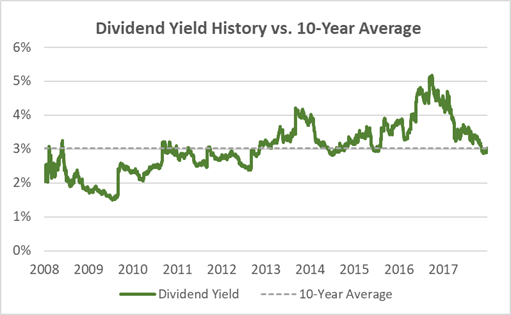Income investors seek a steady stream of dividends. Target‘s (NYSE: TGT) dividend history is long and might make a great addition to an income portfolio. Let’s take a look at the business, dividend history, and payout safety going forward.
Business Overview and Highlights
Target is a $44 billion business. The company is based out of Minneapolis, Minnesota and employs 345,000 people. Last year, Target pulled in $72 billion in sales, which breaks down to $208,000 per employee.
Target works within the consumer sector and holds a solid credit rating (A) from the S&P. This allows Target to issue cheap debt to grow the business and finance other initiatives.
Target acquired Shipt for $550 million last year. The acquisition is helping Target provide same-day delivery from many of its stores. Faster delivery should pull in more customers and push sales higher, and a growing revenue base should help with dividend reliability.
Target’s Dividend History Over 10 Years
The company paid investors $0.62 per share a decade ago. Over the last 10 years, the dividend has climbed to $2.46. That’s a 297% increase! You can see the annual changes below.

The compound annual growth is 14.8% over 10 years… but over the last year, the dividend climbed 4.2%. The slowdown in dividend growth isn’t a great sign. However, Target still might be a good income investment. Let’s take a look at the yield.
Current Yield vs. 10-Year Average
Target’s long history of paying dividends makes it one of the best dividend stocks around. This also makes the dividend yield a great indicator of value. A higher yield is generally better for buyers. Sustainability is also vital, and we’ll look at that soon.
The dividend yield comes in at 3.03%, which is just above the 10-year average of 3.02%. The chart below shows the dividend yield over the last 10 years.

The yield is right at Target’s 10-year average. However, investors have bid up the the company’s market value over the last year. They might be expecting higher growth and payouts. But more often than not, the dividend yield is mean-reverting with share price changes.
Improved Dividend Safety Check
Many investors look at the payout ratio to determine dividend safety. They look at the dividend per share divided by the net income per share. So a payout ratio of 60% would mean that for every $1 Target earns, it pays investors $0.60.
The payout ratio is a good indicator of dividend safety… but accountants manipulate net income. They adjust for goodwill and other non-cash items. A better metric is free cash flow.
Here’s Target’s payout ratio based on free cash flow over the last 10 years.

The ratio is volatile over the last 10 years and the trend is down. But the last reported year shows a payout ratio of 30.6%. This gives plenty of wiggle room for Target’s board of directors to raise the dividend.
Closing Thoughts on Target’s Dividend History and Safety
Target’s dividend growth is slowing down… but the board of directors has plenty of room to keep raising it. The dividend is safe and sound. However, a better investing opportunity might be here soon.
Want to see how one of Target’s top competitors compares? Click the following link: Walmart Dividend History and Safety
Good investing,
Rob
